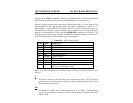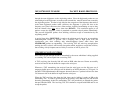
MFJ-1278B MULTI-MODE PACKET RADIO PROTOCOL
provided by the TRACE command. Some texts, including the AX.25 protocol specification,
list the bits in the order in which they are transmitted, which is low order bit first.
The AX.25 protocol presents the control bytes in hexadecimal with "x" used to indicate four
bits that depend on the acknowledge functions the packet is performing. Usually "x" is a
frame number. Frame numbers fit into three bits and are used to ensure that frames are
received in order and that no frames are missed. Since only three bits are available, the frame
number is counted module 8. This is why the MAXFRAME parameter has a ceiling of 7: no
more than seven frames can be "in flight" (transmitted but unacknowledged) at one time. A
short description of the use of the frames is given after the table.
Table 10-1. AX.25 Control Codes
Code Abbrv Frame Type
x1 RR Receive Ready
x5 RNR Receive Not Ready
x9 REJ Reject
03 UI Unnumbered Information
0F DM Disconnected mode
2F SABM Connect request
43 DISC Disconnect request
63 UA Unnumbered Acknowledge
87 FRMR Frame reject
even I Any frame ending in an even number (including $A, $C,
and $E) is an information frame.
Below is a short explanation of the different types of frames associated with the AX.25
protocol:
I
This and UI frames are the only frame types containing user data. The control byte
contains this frame's number and the number of the next frame expected to be received
from the other end of the link.
RR
The RR frame is usually used to acknowledge receipt of an I frame. The RR function
can also be performed by sending an I frame with an updated "expected next frame
number" field.


















